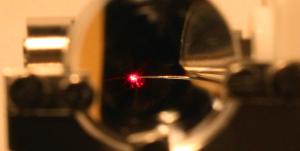Controlled electron pulses

View through a lens: a laser beam strikes a nanotip. Dr. Michael Förster
For this two-colour experiment, as they refer to it, the researchers – Dr. Michael Förster, Timo Paschen, Dr. Michael Krüger and Prof. Dr. Peter Hommelhoff – pumped laser pulses with a duration of approximately a nanosecond through a crystal.
The crystal combined two photons from the laser pulse. In addition to the strong laser pulse being shone on the crystal, another weak pulse of light with a higher frequency was created. Particularly remarkable was the discovery that the new photons exhibited twice the energy of the original photons. In an interferometer, the FAU scientists separated both colours and determined the direction of vibration, intensity and delay of both pulses.
When the laser pulses meet on the tungsten needle, their energy is concentrated at the vertex of its tip. This limits electron emission to the end of the tip. The researchers observed that, under optimal parameters, they could almost perfectly turn on and off electron emission by controlling the delays between laser pulses. This initially came as a surprise, as light energy (photons) can always be found on the tip; therefore this meant that the relative arrival times of the differently-coloured laser pulses determined whether electrons were or were not emitted.
The researchers came to the idea for this control mechanism by comparing experimental results with calculations by physicists working under Prof. Dr. Joachim Burgdörfer at Technische Universität Wien. They surmised that the electrons could interact with photons from both pulses for emission.
This led to two dominant emission paths, but the delay between pulses determined whether these paths would complement or work against each other; emission was either intensified or suppressed in what is known as quantum path interference.
Sharp metal tips have long been used as nearly-punctual electron sources for highest-resolution electron microscopes. Based on the results of this experiment, the researchers hope to create complex electron pulses in the future which could be significant for time-resolved electron microscopy.
The experimental results are also of interest for basic research into surface coherence, as the surface of nanostructures can be particularly well controlled and the nanotips produce exceptionally clear measurement signals thanks to their small dimensions.
The renowned journal Physical Review Letters has published the results in its current issue as the Editors’ Suggestion. This section highlights particularly interesting scientific results for the readers of the weekly journal, providing insight into fields outside the scope of their own research.
Doi: https://doi.org/10.1103/PhysRevLett.117.217601
Further information:
Dr. Michael Förster
Phone: +49 9131 8528874
michael.foerster@fau.de
Media Contact
All latest news from the category: Physics and Astronomy
This area deals with the fundamental laws and building blocks of nature and how they interact, the properties and the behavior of matter, and research into space and time and their structures.
innovations-report provides in-depth reports and articles on subjects such as astrophysics, laser technologies, nuclear, quantum, particle and solid-state physics, nanotechnologies, planetary research and findings (Mars, Venus) and developments related to the Hubble Telescope.
Newest articles

High-energy-density aqueous battery based on halogen multi-electron transfer
Traditional non-aqueous lithium-ion batteries have a high energy density, but their safety is compromised due to the flammable organic electrolytes they utilize. Aqueous batteries use water as the solvent for…

First-ever combined heart pump and pig kidney transplant
…gives new hope to patient with terminal illness. Surgeons at NYU Langone Health performed the first-ever combined mechanical heart pump and gene-edited pig kidney transplant surgery in a 54-year-old woman…

Biophysics: Testing how well biomarkers work
LMU researchers have developed a method to determine how reliably target proteins can be labeled using super-resolution fluorescence microscopy. Modern microscopy techniques make it possible to examine the inner workings…





















